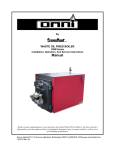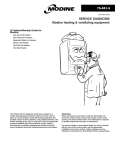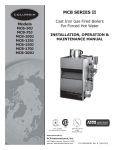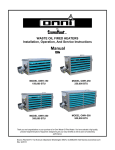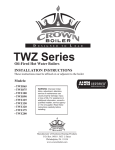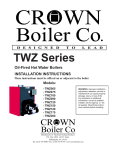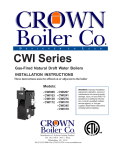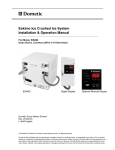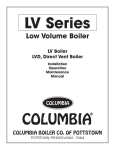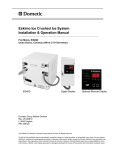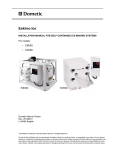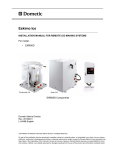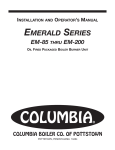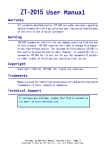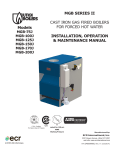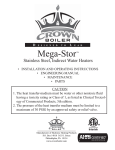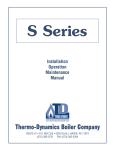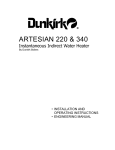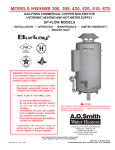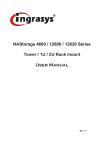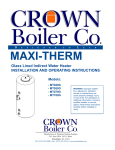Download Amtrol OWB Series Boiler User Manual
Transcript
By WASTE OIL FIRED BOILER OWB Series Installation, Operation, And Service Instructions Manual Thank you and congratulations on your purchase of an Omni Waste Oil Fired Boiler. You have selected a high quality, precision-engineered piece of equipment, designed to give you many benefits as well as years of outstanding performance. Econo Heat♦5714 1st Avenue♦Spokane Washington 99212.♦(509)534-1022♦www.econoheat.com 100270 Rev A3 TABLE OF CONTENTS WASTE OIL BURNER ........................................................................5 OIL BURNER TECHNOLOGY ..........................................................8 OIL BURNER/PUMP TECHNICAL DATA .......................................10 BOILER SPECIFICATIONS ...............................................................11 STANDARD EQUIPMENT.................................................................12 COMBUSTION AIR SUPPLY ............................................................14 CHIMNEY OR VENT REQUIREMENTS..........................................16 LOCATING THE BOILER ..................................................................18 INSTALLING THE BOILER...............................................................19 BREECHING INSTALLATION..........................................................19 INSTALLING BOILER CONTROLS AND ACCESSORIES ............20 WATER PIPING CONNECTIONS .....................................................22 SYSTEM PIPING.................................................................................24 BOILER ASSEMBLY AND WIRING ................................................33 BOILER STARTUP AND ADJUSTMENTS ......................................42 WASTE OIL BURNER STARTUP .....................................................43 WATER TREATMENT .......................................................................43 FREEZE PROTECTION ......................................................................43 MAINTENANCE .................................................................................44 TROUBLE SHOOTING GUIDE .........................................................46 WARRANTY .......................................................................................47 2 Installation, Operation, And Service Instructions PRECAUTIONS Waste oil may contain many foreign materials. Waste oil may also contain gasoline. Therefore, specific precautions on the handling and storage of waste oils are to be observed when using, cleaning and maintaining this heater. Use a screen in a funnel when pouring oil into storage tank to catch foreign material, i.e., gasket material and sealant fibers, etc. WARNING: This appliance is not designated for use in hazardous atmospheres containing flammable vapors or combustible dust, or atmospheres containing chlorinated or halogenated hydrocarbons. Do not expose this unit to rain or moisture. If installed in high moisture atmosphere, a special cover for the integrated air compressor must be obtained from factory to avoid rusting of internal raw metals. If this occurs, see trouble-shooting guide for remedy. Uses only crank case oil, gear oil, hydraulic oils, auto trans. Fluid or #1 and #2 furnace oil. Do not use old, contaminated oils that have been stored in underground tanks or outside barrels for long periods. Excessive water and sludge may be present, causing quick filter plugging. NOTES: The instructions contained in this manual apply to the installation, operation, and service of Omni Waste oil fired boiler. The following instructions should be carefully followed for obtaining the best possible installation, operation and service conditions. Specifications are subject to change without notice. This product was designed to provide an economical disposal of waste oil. Proper operation depends on the consistency of the oil. Any water or foreign material in the oil may cause the unit to shut down. This appliance is designed for commercial or industrial use only. UNCRATING: Immediately upon uncrating units, check rating plate for certainty of electrical and mechanical characteristics. Also check the unit for any damage that may have been incurred in shipment, if any damage is found, file a claim with the transporting agency. The unit has been tested and inspected at the factory prior to crating and was in perfect condition at that time. If anything is missing check packing slip for indications of possible backorder of those parts or components. Otherwise a claim must be for those missing parts. Installation, Operation, And Service Instructions 3 IMPORTANT NOTICE TO OWNER AND INSTALLER To enjoy the long term benefits of burning your used oil in an Omni Waste Oil Boiler, it is necessary to become familiar with the correct installation operation and maintenance of your new boiler. Before installing or operating this appliance, make sure you read and understand this manual. IMPROPER INSTALLATION OR LACK OF MAINTENANCE WILL VOID THE WARRANTY ------------WARNING-----------Improper Installation, adjustment, alteration service or maintenance can cause property damage, injury, or loss of life. For assistance or additional information consult a qualified installer or service agency. Read these instructions carefully before installing Identical to any oil burning appliance, without adequate draft over the fire, the combustion gases cannot escape the appliance. The flame will lengthen resulting in an overheated combustion chamber. Even if the heater is installed correctly and adequate draft achieved, a flue passage blockage will affect the draft. Burning used oil is similar to burning wood. A fine gray ash accumulates in the chamber and flue passage. This accumulation of ash will eventually affect the draft. It is important to remove this ash before the draft is affected. Note: All illustrations and specifications contained herein are based on the latest information available at time of publication approval. Econo Heat reserves the right to make changes at any time without notice, in material and specifications. 4 Installation, Operation, And Service Instructions WASTE OIL BURNER WARNING ONLY Authorized Technicians strictly complying with the manufacturer’s instructions and the local standards should perform installation, maintenance and service on the unit’s internal components. Installation and use of this used oil burning appliance shall be in accordance with the standard for the Installation of Oil Burning Equipment – ANSI/NFPA 31 – 1987, and National Electric Code – ANSI/NFPA 70 – 1990 and the requirements of the inspection authorities having jurisdiction. Oil Primary Control Igniter Transformer Air Pressure Adjuster Air Band (Combustion Air Supply Adjustment) Air Compressor Power Switch Run Indicator Power Indicator Oil Pressure Gauge Air Pressure Gauge Figure 1 – Oil Burner (Back View Closed) Installation, Operation, And Service Instructions 5 Pre-Heater Control Circuit Board Oil Pre-Heater Block Air Muffler/Filter Photo Eye Flame Sensor Electrical Terminal Block Transformer Igniter Springs Heater Electrical Schematic Figure 2 – Oil Burner (Back View Opened) Electrodes Oil Valve Nozzle Burner Motor Flame Cone Figure 3 – Oil Burner (Front View) 6 Installation, Operation, And Service Instructions Oil Outlet Oil Inlet Figure 4 –Oil Pump Diagram Figure 5 –Oil Pump Assembly Installation, Operation, And Service Instructions 7 OIL BURNER TECHNOLOGY Omni’s patented burner technology improves the efficiency of the oil burn process by continuous stabilization of the oil viscosity. Optimum atomization (spray) is accomplished by precisely preheating the oil and air prior to introduction to the combustion chamber. The waste oil enters into the Oil Pre-Heater Block (figure2) and is pre-heated to operating thermo setpoint, then compressed air from the air compressor (figure1) is mixed with the oil prior to spraying out the nozzle similar to fuel injection, by breaking up the oil droplets into a finer mist or spray (atomization). Electrodes mounted just above the nozzle (figure3) provides continuous electrical arc across electrode to electrode igniting the fine oil mist as it sprays out of the nozzle. Once ignited the flame is forced into a swirl caused by the burners blower and specially designed flame cone (figure3) providing a very efficient and thorough burn of the waste oil. Burner Components 8 • Igniter Transformer: (figure1) Supplies high voltage to the electrodes generating electrical arc igniting the oil. • Oil Valve: (figure3) energizes when burner is running and de-energizes when burner is not running eliminating bleed back of oil out of the Pre-heater block. • Air Band: (figure1) Adjusts amount of air introduced into the combustion chamber. • Oil Primary Control: (figure1) Controls the oil burner ignition. Checks for flame in the combustion chamber, if no flame is detected within 45 seconds, the oil primary will shutdown the oil burner. To restart the unit, reset the red button on the oil primary. • Oil Pre-Heater Block: (figure2) Pre-heats the oil and air before entering combustion chamber. • Photo Eye: (figure2) Senses flame in combustion chamber and signals oil primary when no flame is present. • Igniter Springs: (figure2) Transfers the high voltage from the igniter transformer to the electrodes (when door is closed) • Air Pressure Gauge: (figure1) Displays air pressure supplied by onboard air compressor. • Air Compressor: (figure1) Supplies air used within pre-heater block to aid in atomization of the oil. • Air Muffler/Filter: (figure2) Filters air and muffles the sound generated by the compressor. • Pre-Heater Control Circuit Board: (figure2) Precisely controls temperature of the Oil Pre-Heater Block and controls safety feature of not allowing burner to energize until oil has established operating thermo setpoint or shutdown burner if Pre-Heater Block temperature falls below shutdown thermo setpoint. • Electrodes: (figure3) Provides continuous high voltage electrical arc from electrode to electrode igniting the waste oil as it is being sprayed out of the nozzle. • Nozzle: (figure3) Low pressure nozzle for oil spray pattern. • Flame Cone: (figure3) Specially engineered flame cone forces the flame into a swirl pattern improving the burn thoroughness. • Burner Motor: (figure3) Multitask motor turns the burner blower and integrated air compressor. Installation, Operation, And Service Instructions • Air Pressure Adjuster: (figure1) Adjusts the air pressure going to the pre-heater block. Should be adjusted between 12 PSI and 13PSI as indicated on the Air Pressure Gauge on the burner for thorough burn of the waste oil. Note: In order to insure proper air adjustment, air gauge must read 0 when burner is cycled off or powered down. • Oil Pressure Gauge: (figure1) Displays oil pressure at the burner. Adjustment at the Oil Pump must be made to achieve oil pressure readings at the burner as indicated below. Boiler Model Oil Pressure Reading At Burner OWB-9 1 PSI OWB-15 2 PSI OWB-25 4 PSI OWB-35 6 PSI OWB-50 11 PSI • Power Indicator: (figure1) Indicates when power is present at the burner. • Run Indicator: (figure1) Indicates that the burner is ready for operation after the initial pre-heat time of approx. 5 minutes from initial power up. • Power Switch: (figure1) Switches power off and on to the burner. Installation, Operation, And Service Instructions 9 OIL BURNER/PUMP TECHNICAL DATA BURNER ASSEMBLY Performance Ratings Voltage Cycles Total Operating Amperage (Burner Only) Total Operating Amperage (Burner and Oil Pump) Electrical Operating Consumption (Burner Only) Electrical Operating Consumption (Burner and Oil Pump) Weight Oil Primary Oil Valve Pre-Heater Block Pre-Heater Controller Board Igniter Transformer Burner Motor Amp Amp Watts Watts Lbs Amp Amp Amp Amp Amp Amp 115 VAC 60Hz 8.4 10.5 970 1,212 36.5 0.2 0.075 4.2 0.011 0.3 3.6 Amps Watts Lbs Amps Amps 115Vac 60Hz 2.1 241.5 16 0.075 2.0 PUMP ASSEMBLY Performance Ratings Voltage Cycles Total Operating Amperage (Pump Assy Only) Electrical Operating Consumption (Pump Assy Only) Weight Oil Valve Pump Motor 10 Installation, Operation, And Service Instructions BOILER SPECIFICATIONS Figure 6 –Boiler (OWB-35 & OWB-50) OWB series boilers are three pass Scotch Marine design with fully water backed transfer surfaces. Boilers are designed for use in forced hot water heating systems. Heating is supplied by a Waste Oil Burner that burns all petroleum products any weight combination up to SAE 90W as well as fuel oils. Boiler–Burner units operate with no less than 0 to –0.01WC over fire and may be vented using a conventional chimney. Installation, Operation, And Service Instructions 11 CODE REQUIREMENTS Installations must comply with all state, local, and utility codes, laws, regulations, and ordinances, and CSA standard B139. Where required by the authority having jurisdiction, the installation must conform to American society of Mechanical Engineers Safety Code for Controls and Safety Devices for Automatically Fired Boilers, No. CSD1. All electrical wiring must be done in accordance with the National Electrical codes latest edition and all state and local codes. STANDARD EQUIPMENT * Factory Assembled Cast Iron Sections * Flow Control Oil Supply Pump * Insulated Jacket * Theraltimeter Gauge * Boiler Drain * Circulator – Except Models 35 and 50 * Relay – Models 35 and 50 Only * Pre-built Control Manifold Models 35 and 50 Only 12 * Refractory Insulated Hinged front Door With Sight Glass * ASME Relief Valve 30 PSI * Draft Inducer (optional) * High Limit Aquastat Relay Combination (L-8148°) Except Models 35 and 50 * Serviceable Oil Filter * Low Water Cut-off Control * Manual Reset High Limit Aquastat Control Installation, Operation, And Service Instructions 9-3/8” Centerline Of Burner Plate 2-1/2 M.P.T. Supply Connection 36” 29-1/2” 20” 17” 3/4” L 33” 4” 8” 2-1/2 F.P.T. Return Connection Approx. 14” OWB-35 and OWB-50 Specifications 1-1/2” Supply Connection 26” Circulator 21-1/2” 15-1/2” 12-1/4” 1-1/2” Return Connection L 25” Approx. 14” OWB-9, OWB-15, and OWB-25 Specifications Boiler Model Burner GPH Input BTU’s Output Capacity BTU’s NET Rating Water BTU/HR. NET Rating Water SQ.FT. Approx. Dry Weight Lbs. Vent Connect Dia. Inches Dim “L” Inches Water Content Gal. Max. Water Working Pressure OWB-9 .60 90,000 76,500 66,500 522 527 7 24-1/4 5.5 60PSI OWB-15 1.0 150,000 127,500 110,800 875 716 7 34-1/4 8.2 60PSI OWB-25 1.7 250,000 212,500 184,700 1,450 902 7 44-1/4 10.8 60PSI OWB-35 2.4 350,000 297,500 258,600 2,030 1654 10 52 28.5 75PSI OWB-50 3.3 500,000 425,000 369,500 2,900 1831 10 57 31.7 75PSI Table 1. NOTES: 1. 2. 3. 4. Net ratings shown are based on a piping and pick-up allowance of 1.15. Net ratings in sq. ft. are based on 170 deg F average water temperature in radiators. For higher water temperatures, select boiler on basis of net ratings in BTU/HR. Firing rate in G.P.H. is based on oil having heat value of 150,000 BTU/GAL. 4% reduction of output for every 1,000 ft. of elevation. Installation, Operation, And Service Instructions 13 COMBUSTION AIR SUPPLY WARNING Failure to provide an adequate supply of fresh air for combustion will result in hazardous operating conditions. Note If you use a fireplace or a kitchen or bathroom exhaust fan, you should install an outside air intake. These devices will rob the boiler and water heater of combustion air. 1. In unconfined spaces in buildings infiltration may be adequate to provide air for combustion and ventilation. However, in buildings of unusually tight construction, additional air must be provided as described in Item2. (b) below. 2. Boiler located in confined space: [Note: Confined space may be defined as a space whose volume is less than 50 cubic feet per 1000 Btuh of total input of all appliances installed in that space.] (a) All air from inside of building: Providing infiltration in the rest of the building is adequate, the confined space may be provided with two permanent openings communicating directly with another room or rooms of sufficient volume that the total volume of all spaces meets the criteria for unconfined space. One opening must be within 12 inches of the bottom of the enclosure. See Figure 7. Chimney Opening Note: Each opening shall have a free area of not less than one square inch per 1,000 Btu per hour of the total input rating of all equipment in the enclosure, but not less than 100 square inches. Opening Figure 7. 14 Installation, Operation, And Service Instructions (b) All Air From Outdoors: The confined space shall be provided with two permanent openings, one within 12 inches of the top and another within 12 inches of the bottom of the enclosure. The openings shall communicate directly, or by ducts, with the outdoors or crawl or attic spaces which communicate freely with the outdoors. Direct To Outdoors, See Figure 8. Chimney Ventallation Louvers (each end of attic) Outlet Air Alternative Air Inlet Inlet Air Note: The inlet and outlet air openings shall each have a free area of not less than one square inch per 4,000 Btu per hour of total input rating of all equipment in the enclosure. Ventallation Louvers for Unheated Crawl Space Figure 8. With Vertical Ducts See Figure 9. Chimney Ventallation Louvers (each end of attic) Outlet Air Note: The inlet and outlet shall each have a free area of not less than one square inch per 4,000 Btu per hour of the total input rating of all equipment in the enclosure. Inlet Air Duct (ends 1 ft. above floor) Figure 9. Installation, Operation, And Service Instructions 15 NOTE All wall openings directly to outdoors must be screened to prevent entry by birds or small animals. With Horizontal Ducts See Figure 10. Chimney Note: Each air duct opening shall have a free area of not less than one square inch per 2,000 Btu per hour of the total input rating of all equipment in the enclosure.* Outlet Air Duct Inlet Air Duct *If the equipment room is located against an outside wall and the air openings communicate directly with the outdoors, each opening shall have a free area of not less than one square inch per 4,000 Btu per hour of the total input rating of all equipment in the enclosure. Figure 10. CHIMNEY OR VENT REQUIREMENTS WARNING Inspect existing chimney to make sure it is clean, the right size, properly constructed and in good condition before installing boiler. Failure to do so may cause a hazardous operating condition. NOTE Venting must conform with applicable local codes and for the National Board of Fire Underwriters. 1. Chimney must be a Class A chimney. 2. This is a high efficiency boiler which operates with a low stack temperature which may be subject to condensation in a cool or improperly designed chimney. Accordingly, the right vent or liner is very important. a) Masonry chimney with three walls exposed to outdoors may require the use of a 316 stainless steel liner. b) Masonry chimney with all inside walls—use a tile liner. 16 Installation, Operation, And Service Instructions 3. Breeching • See Table 2 for minimum recommended breeching and chimney sizes. • Keep run boiler to chimney as short as possible. • Use as few elbows as possible. • Slope upward towards chimney at not less than 1/4” per foot. • Use a sealed-in thimble for the chimney connection. • Connect together all sections and/or fittings with sheet metal screws and seal with silicone sealant. 4. When more than one appliance is connected to the same chimney, the chimney’s internal cross-sectional area must be at a minimum equal to the area of the largest vent plus 50% of the area of each additional vent. 5. Clearances—vent pipe between boiler and chimney must be a minimum of 6” from any combustible material. MINIMUM RECOMMENDED BREACHING AND CHIMNEY SIZE. Boiler Model Min. Breeching Dia. OWB-9 OWB-15 OWB-25 OWB-35 OWB-50 6” 7” 7” 10” 10” Min. Recommended Chimney Size I.D. HT. 6” 15’ 7” 15’ 8” 20’ 10” 15’ 10” 15’ Table 2. 6. An oil-fired unit shall be connected to a flue having sufficient draft at all times, to assure safe proper operation of the unit. Installation, Operation, And Service Instructions 17 SIDE-WALL VENTING---IMPORTANT NOTE Two problems arise when side wall venting any oil appliance; 1. There is sometimes an accelerated rate at which soot builds up on the cad-cell, spinner, etc. 2. There is the potential for severe soot damage to the side of the structure in the event that the boiler operates at a high smoke level. This can happen for many reasons, some of which are out of the control of both the installer and appliance manufacturer. Econo Heat recommends the use of a chimney to vent our residential oil boilers. If a power venter must be used, it is the responsibility of the installer and power vent manufacturer to “engineer” the power vent system. ECONO HEAT WILL ASSUME NO REPONSIBILITY FOR SOOT DAMAGE TO SIDING, ETC. FROM A POWER VENTED OIL BOILER. THIS APPLIES REGARDLESS OF THE CAUSE OF THE SOOTING. LOCATING THE BOILER WARNING Boiler must not be installed in an area where gasoline, paint or other combustible materials or flammable vapors or liquids are present. 1. Consider all piping and venting connections before selecting a location. Locate as close to the chimney as possible, observing the following clearances requirements from combustible surfaces: Front ......................24” Top ......................... 6” above controls Left Side ................. 6” Right Side ............... 6” Back ........................18” 2. Boiler is not intended for installation on combustible floor. Further, to facilitate servicing it is desirable to raise the boiler at least 8” off the floor. It is recommended that concrete blocks be employed to build up a foundation. Ensure that top surface of foundation is level. 18 Installation, Operation, And Service Instructions INSTALLING THE BOILER Placing The Boiler (OWB-9 – OWB-25) 1. Move the boiler as close as possible to its final location in the crate. 2. Remove the two lag screws holding the rear feet to the skid. 3. Remove the front jacket panel. Cut the band holding the front of the boiler to the skid. 4. Move the boiler into the final position. 5. Waste Oil Piping: USE ONLY 3/8” nominal ID copper tubing with flare fittings only on the oil suction from the tank to the oil pump and oil pump to burner. DO NOT use ferrule fittings or teflon tape on any pipe fittings. Keep suction line approximately 6” from bottom of oil tank to prevent suction of sludge (Figure 11). Use only an inside oil storage tank. Do Not draw from an outside tank, especially not an underground tank directly to burner. A separate transfer pump from an outside tank with proper filtration to the inside supply tank is acceptable. 6. The fuel pump included with burner is to be mounted at tank level or below. PUMP MUST BE MOUNTED HORIZONTAL AND LOCATED NEXT TO WASTE OIL SUPPLY TANK. 1, Oil Feed Line, 3/8” to connector on burner gun assembly 2,O Suction Line, 3/8” copper tubing 3, Suction Line 6” min from bottom of tank to prevent sludge from being introduced into the supply line 1 2 3 Waste Oil Supply Tank Waste Oil Pump Boiler Figure 11. BREECHING INSTALLATION The breeching connection on OWB-9, OWB-15 and OWB-25 is 7 inches regardless of input. Refer to Table 1 for minimum breeching sizes. Breeching run should be as short as possible with as few elbows a practical. Unless marginal draft conditions exist, a brametric draft control must be installed in the breeching and should be approximately 18 inches from the boiler breeching connection. Breeching should not project into the chimney beyond the inside wall of the chimney. Connect the breeching to the chimney with a thimble or slip joint to facilitate cleaning. See Figure 12. Installation, Operation, And Service Instructions 19 Pitch Up 1/4” per foot Barometric Draft Control 18” Straight Run Preferred Figure 12. INSTALLING THE BOILER CONTROLS AND ACCESSORIES 1. Accessories for Boilers OWB-9, OWB-15, and OWB-25: a) Take the L8148A Aquastat relay, the well, the pressure relief valve with pipe nipple and the temperature/pressure gauge from the large carton which was packed in the wirebound crate. Install in tappings provided at the top rear of the boiler as shown in Figure 13. Figure 13. b) c) 20 Take the boiler drain from the same carton and connect it to the 3/4 inch opening of the 1 1/4 x 3/4 x 1 1/4 inch tee in the boiler return manifold at the bottom rear of boiler. Install 1 1/4 x 3” Nipple and Circulator Flange. Installation, Operation, And Service Instructions d) Remove the circulating pump from its carton in the crate and mount it to the pump flange on the end of the return manifold. 2. Bare Boiler: a) b) 1. The pressure relief valve and temperature/pressure gauge are supplied with the boiler and should be mounted as shown in Figure 13. The bare boiler does not include the return manifold. The installer must make up his own manifold to connect to the 2 x 1 1/4 inch bushing which is supplied in the boiler supply and return ports, and must provide his own boiler drain and circulating pump. Accessories for Boilers OWB-35 and OWB-50: Figure 14. Supply Manifold Assembly Figure 15. Return Diffuser Installation a) Attach supply manifold as shown in Figure 14. b) Install return port diffuser and attach return flange as shown in Figure 15. Make sure diffuser SLOTS face upward. c) Screw threading used on these parts are metric. There is no english thread equivalent to the nuts or studs supplied. Attempts to use any english threaded stud in place of those supplied will damage the boiler block. Installation, Operation, And Service Instructions 21 WATER PIPING CONNECTIONS 1. OWB-9, OWB-15, and OWB-25 boilers are shipped complete with circulating pump. To make the piping connections to the boiler ready to connect to the system piping, the following will also be required at a minimum: 1 – Air Purger (same size as supply pipe) 1 – Pressure reducing Fill Valve 1 – Expansion Tank (sized to system design requirements) 1 – Automatic Air Vent 2. The following accessories may also be required, depending upon overall system design and code requirements: 1 – Low Water Cutoff may be required if boiler is located above radiation level. Check requirements of state or local code bodies and insurance companies. If required use a probe-type designed for water system use and install in tee in supply piping above the boiler. 1 – Manual Reset High Limit----Required by some state or local codes. Also required if system is to comply with ASME code. 1 – Backflow Preventer----- Required by many State and local codes. 3. Additional circulating pumps or zone valves may also be required if the system is to be multi-zone or if it is to include a domestic hot water storage tank with coil. WARNING The expansion tank must be properly sized to system requirements. An under-sized expansion tank will cause system water to be lost through the relief valve and make-up water to be introduced through the fill valve. Continual introduction of fresh water into the system will cause mineral build-up in the boiler sections and eventual section failure. 4. There are two types of expansion tanks used, the closed type and the pre-pressurized diaphragm tank Most new installations use the diaphragm type tank, however some installations still employ the closed type tank. (a) Piping Connections with closed type expansion tank----See Figure 16. Piping from tee in supply to tank should be 3/4 inch. If horizontal piping is employed, pipe must be pitched up toward tank 1/4 inch per foot. 22 Installation, Operation, And Service Instructions Closed Type Expansion Tank Pressure Relief Valve 3/4 in. Supply to System Shutoff Valve S Cold Water Feed Fill Valve R Return From System Drain Cock Circulation Pump Figure 16. (b) Piping connections with diaphragm expansion tank--- See Figure 17. The cold water feed to the pressure reducing fill valve may be piped with 1/2 inch pipe. Shutoff Valve Purger Auto Air Vent S Cold Water Feed Diaphragm Type Expansion Tank R Drain Cock Circulator Pump Figure 17. Installation, Operation, And Service Instructions 23 SYSTEM PIPING Supply and return and system piping should be sized by determining the pressure drop, required flow rate and pump capacity. WARNING Discharge piping from relief valve must be piped to a drain or must terminate 6” above floor to eliminate damage to the structure or personal injury. It must not be piped to a point where freezing might occur. 1. MULTIPLE ZOINING WITH ZONE VALVES ----- See Figure 18. Install a balancing valve in each zone and adjust so that flow is about the same in each zone. Isolation Valves Shutoff Valves S Cold Water Feed R Zone Valves Drain Cock Circulation Pump Figure 18. 24 Installation, Operation, And Service Instructions Isolation Valves Flow Control Valves Shutoff Valve S Cold Water Feed R Drain Cock Isolation Valves Circulating Pumps Figure 19. 2. MULTIPLE ZONING WITH CIRCULATORS ----- Each pump will require a separate relay (Honeywell R845A or White Rodgers 829A845, or equivalent). Install a flow control valve in each zone including the indirect water heater to prevent gravity circulation. Install a balancing valve in each zone and adjust so that flow in each zone is about the same. See Figure 19. 3. RADIANT PANEL OR OTHER LOW TEMPERATURE SYSTEM---- The temperature of the system water coming back to the return port of the boiler must not be permitted to drop below about 135 Degree F for an extended period of time. Return water temperatures of 130 Degree F or lower will cause condensation on the exterior surface of the heat exchanger and corrosion and eventual heat exchanger failure will result. Radiant floor and ceiling panel heating systems typically operate with maximum supply water temperatures of 140 Degree F or less. A standard piping arrangement would, under these circumstances, permit return water temperatures of 120 Degree F and lower. Accordingly, such systems must be piped such that the return water temperature will be high enough at all times to prevent condensation. See Figure 20. Installation, Operation, And Service Instructions 25 Return from System Supply to System Stem Thermometer Shutoff Valve Circulating Pumps S Bypass A Cold Water Feed R Drain Cock Circulating Pumps Adjust the two manual valves to maintain 160 degree F or more in the boiler while holding the supply water temperature at the stem thermometer at 140 degree F or whatever minimum temperature system requires. Figure 20. NOTE Bypass A shown in figure 20. above should not exceed 12 inches in length. If it is not practical to maintain a 12 inch length or less then increase the pipe size of the bypass by one size. 4. LARGE WATER CONTENT SYSTEMS------ Such systems as converted gravity systems, old systems with cast iron radiators, and also newer systems that employ outdoor reset control present a potential problem with low return water temperatures and condensation. The boiler must be protected from condensation in such cases by using a by-pass as shown in Figure 21. 26 Installation, Operation, And Service Instructions Supply to System Shutoff Valve S Cold Water Feed R Return from System Circulating Pumps Drain Cock Adjust the two manual valves to maintain 135 degree F or more in the boiler with return water at the lowest temperature to be expected. Figure 21. 5. INTEGRATED SYSTEM (HEAT AND DOMESTIC HOT WATER) ----- With a single heating zone priority for domestic hot water may be provided through the use of a 3-port zone valve. This system assures that full boiler output is available to recover the storage tank quickly and should be used where supply of domestic hot water on demand is critical. For this application use a full throated valve with a minimum pressure drop. See Figure 22. Installation, Operation, And Service Instructions 27 Indirect Water Heater (Storage Tank With Coil) Supply to System Shutoff Valve S 3 Port Zone Valve Cold Water Feed R Return from System Drain Cock Circulating Pumps Figure 22. 6. INTEGRATED SYSTEM WITH MULTIPLE HEATING ZONES AND NO PRIORITY FOR DOMESTIC HOT WATER, USING ZONE VALVES----Where the boiler output is large relative to the heating capacity of the coil in the indirect water heater priority for domestic hot water is not necessary. Further, with multiple heating zones there is less likelihood that all zones will call for heat at once and require full boiler output for heating. Because the tank is usually close to the boiler, the pressure drop through the coil circuit will generally be less than through a heating zone circuit, which will provide some measure of priority for domestic hot water. This can be enhanced by increasing the pipe size to the coil e.g. if 3/4 inch pipe is used on the heating zones run 1 inch pipe to the coil. (See Figure 23.) Should priority for domestic hot water be mandatory, it can be provided as shown in Wiring Section, Figure 24. 28 Installation, Operation, And Service Instructions Indirect Water Heater Supply to System Shutoff Valve S Zone Valves R Cold Water Feed Return from System Drain Cock Circulating Pumps Figure 23. 7. INTEGRATED SYSTEM, SINGLE OR MULTIPLE HEATING ZONES, USING CIRCULATING PUMPS RATHER THAN ZONE VALVES---Each pump will require a separate relay (Honeywell R845A or White Rodgers 828A845, or equivalent). Install a flow control valve in each zone including the indirect water heater to prevent gravity circulation. Install a balancing valve in each zone and adjust so that flow in each zone is about the same. (see Figure 24.) While this basic system does not provide priority for domestic hot water, priority can be provided as shown in Wiring Section, Figure 27. Indirect Water Heater Supply to System Shutoff Valve S Flow Control Valves Cold Water Feed Return from System R Circulating Pumps Drain Cock Figure 24. Installation, Operation, And Service Instructions 29 8. COMBINATION HEATING/COOLING SYSTEM WITH CHILLED WATER The chiller must be piped in parallel with the boiler and isolation valves installed to prevent the chilled water from circulating through the boiler and heated water from circulating through the chiller. See Figure 25. Chiller Insulation Valve # 4 Supply to System Insulation Valve # 4 S Circulating Pumps Insulation Valve # 3 Return from System Cold Water Feed R Flow Check Drain Cock Note: 1. When in cooling mode isolation valves 1 and 2 must be closed and valves 3 and 4 open. 2. When in heating mode isolation valves 1 and 2 must be open and valves 3 and 4 closed. Figure 25. 9. SINGLE BOILER PIPING WITH BLEND PUMP When burner is operating the water flow throughout the boiler shall be not less than 1.8 GPM for each 100,000 BTU/HR of gross boiler output. Size blend pump accordingly. See Table 3 Blend Pump Boiler Model GPM Primary/Secondary Pump GPM OWB-9 OWB-15 OWB-25 OWB-35 16.3 78.9 OWB-50 19.6 94.9 Maximum water flow resistance for boilers is 14” w.c Table 3. 30 Installation, Operation, And Service Instructions Amtrol #720 Air Eliminator or Equal System Supply Air Separator S System Circulator R Pressure Reduction Valve Blend Pump To Size Blend Pump See Table 3 Backflow Preventer System Return Check Valve From City Water Supply Expansion Tank Figure 26. 10. SINGLE OR MULTIPLE BOILER PIPING FOR PRIMARY/SECONDARY PUMPING Size Secondary Pump GPM at Gross Boiler Output for 20” Drop. When Calulating Pump Head, the Maximum Boiler Resistance for any Boiler will not Exceed 14 in. W.C. Head. Amtrol #720 Air Eliminator or Equal Secondary Pump System Supply S Check Valve S R Secondary Pump R Air Separator Pressure Reduction Valve Check Valve 12” MAX System Return System Circulator 12” MAX Expansion Tank Backflow Preventer From City Water Supply Figure 27. Installation, Operation, And Service Instructions 31 11. MULTIPLE BOILER PIPING- REVERSE RETURN FLOW WITH BLEND PUMP Amtrol #720 Air Eliminator or Equal S S R Check Valve Air Separator System Supply System Circulator R Pressure Reduction Valve *Blend Pump Backflow Preventer *Blend Pump Check Valve System Return Expansion Tank From City Water Supply Figure 28. 32 Installation, Operation, And Service Instructions BOILER ASSEMBLY & WIRING Burner Mounting NOTE: When the burner is field installed the installer must fill in the space between the burner blast tube and the insulation block on the inside of the burner door with refractory mix provided. Figure 29. OWB-35 and OWB-50 Burner Mounting & Boiler Door Detail Figure 30. OWB-9, OWB-15 and OWB-25 Burner Mounting & Boiler Door Detail Installation, Operation, And Service Instructions 33 Boiler Jacket Assembly 26 25 26A Sight Class Assy 33 86 60 38 48 94 36 43 18 41 93 18 40 Figure 31. OWB-35 and OWB-50 Assembly Detail OWB-35 and OWB-50 Jacket Installation Instructions 1. Screw the four extension setscrews (43) into the four outer holes in the corners of the rear sections. Securely tighten the setscrews and other fastening bolts of the flue outlet cover (22) 2. Place the large wraparound insulation mat (40) over boiler block (aluminum foil side facing out). 3. Place smaller piece of insulation on top of wraparound insulation. This will provide double thick insulation on top of the boiler block. 4. Remove flue collector clean-out covers (62) 5. Push the two smaller pieces of insulation (60) onto the flue collector (22) so that the four extension setscrews (43) protrude through the insulation. 6. Attach rear jacket panels (36) and (38) to the two extension screws(43) using the M6x10 pan head screws. Screw the rear panels together in the center using sheet metal screws provided. Reattach the clean-out covers. 7. Place right and left side panels (93) (94) into the factory mounted hinge bracket (18) and hook into the rear panels (36) (38). 34 Installation, Operation, And Service Instructions 8. Hook center panel (33) with flange edge down between side panels (93) and (94). 9. Attach the upper front trim panel (41) between the right and left side panels over the front door. 10. Place the top panel (86) in position. Hook to the side panels. 11. Remove sight glass plug in front door and install sight glass assembly. Sight Glass (25) Sight Glass Tube Cap(26) and Sight Class Gasket(48). Figure 32. OWB-9, OWB-15 and OWB-25 Assembly Detail OWB-9, OWB-15 and OWB-25 Jacket Installation Instructions 1. Attach the rear jacket mounting brackets (7) to rear tie rod ends on back of boiler using the 12mm nut (9) provided on the end of each tie rod. 2. Attach the rear jacket panel (3) to the rear jacket mounting bracket using the 1/420 screws (11) ans nuts (10) provided. 3. Assemble front jacket mounting bracket (23) to the heat exchanger using the two M10x16mm cap screws (27). 4. Drape the foil faced fiberglass insulation mat (not shown) over the top and sides of the boiler. Make sure that the insulation is behind the Door Hinge and Front Mounting Bracket and that the tappings in the top of the boiler are not covered by the insulation. Installation, Operation, And Service Instructions 35 5. Attach one door bracket (18) to the bottom of both the left and right side jacket panels. Use two 8-32x1/2” screws (19) and nuts (20) to assemble each door bracket. 6. Attach the left and right side jacket panels to the boiler. The front end of the right side panel is attached to the hinge using 10-24x3/4 screws (21). The front end of the left side panel is also attached to the front jacket mounting bracket (23) using 10-24x3/4 screws. The rear of both the left and right panels are attached to the rear panel using #10x1/2 sheet metal screws. 7. Install a #10x1/2 sheet metal screw into the remaining hole in the rear of the right side jacket panel which secures the rear of the wireway. 8. Attach the top jacket panel (5) using four #10x1/2 sheet metal screws. 9. Attach the flue collector cover (4) using four #10x 1/2 sheet metal screws. 10. Press the door switch (16) into the door switch bracket (17). Connect the door switch leads to the switch (it does not matter which wire is connected to which side of the switch). Attach the door switch bracket to the right side jacket panel using a 10-24x3/4 machine screw (21). 11. Mount the door knobs (25) to the front panel (24) using two 8-32x1/4 screws (26). 12. Mount the front jacket panel on the boiler. 13. Connect the loose end of the 6” conduit assembly to the limit control. Connect the black wire to terminal “B1” and the white wire to terminal “B2”. Boiler Tube Insert Assembly Dam Install Stainless Steel Tube Insert with external stitch weld touching 1st water section high point of casting and the dam located at the 6 O’clock position. (bottom of boiler). When boiler door is closed, stainless tube will inbed into door refractory at least 1/4”. 36 Installation, Operation, And Service Instructions Single Zone Wiring WARNING All wiring and grounding must be done in accordance with the authority having jurisdiction or, in the absence of such authority, with the National Electrical Code (ANSI/NFPA70). 1) 120 Volt Wiring—The boiler should be provided with its own 20A branch circuit with fused disconnect. All 120 volt connections are made inside the L8148A aquastat relay as follows (also see Fig. 31 or 32): • • • Hot (“black”)- Terminal “L1” Neutral (“white”)- Terminal “L2” Ground (“Green” or bare)- Ground screw on case of L8148A 2) Thermostat Wiring—Follow thermostat manufacturer instructions. To insure proper thermostat operation, avoid installation in areas of poor air circulation, hot spots (near any heat source or in direct sunlight), cold spots (outside walls, walls adjacent to unheated areas, locations subject to drafts). Provide Class II circuit between thermostat and boiler. Connect thermostat wire leads to terminals “T” and “T” inside L8148A aquastat relay. Wiring Variations 1) Multiple Circulator Zones—Figure 35 shows wiring for two or more circulator zones using Honeywell R845As. One R845A is required for each circulator zone. Circulator terminals “C1” and “C2” on the L8148A are not used. A DPST Honeywell RA832A may be substituted in place of the R845A using the “X” and “X” terminals in place of the “5” and “6” terminals on a R845A. A call for heat from any thermostat will energize the DPST relay in that zone”s R845A. When this relay is energized, electrical continuity is created between terminals 3 and 4, energizing the circulator for that zone. At the same time, electrical continuity is created between terminals 5 and 6 on the R845A, creating a current path from terminal “T” to “T” on the L8148A. Assuming that the supply water temperature is below the high limit setting, the normal ignition sequence will be initiated. 2) Multiple Zones using Zone Valves—Figure 34 shows wiring for multiple zones using Honeywell V8043F zone valves. This wiring diagram may be used for other 24-volt zone valves as long as they are equipped with end switches. Do not attempt to use the transformer on the L8148A to power the zone valves; use a separate transformer. Up to five V8043Fs may be powered by one 48VA transformer, such as the Honeywell AT87A. A call for heat from a given thermostat will result in the application of 24 volts across the TH and TR terminals on the corresponding zone valve, energizing the zone valve motor. The zone valve opens and the end switch contacts are then made. The end switches are connected in parallel with each other and to the “T” and “T” Installation, Operation, And Service Instructions 37 thermostat connections so that any zone valve that opens will also start the circulator and fire the boiler(assuming the high limit is not open). Zone valve terminal TH/TR has no internal connection on the zone valve; it is merely a “binding post” used to connect two or more wires. 38 Installation, Operation, And Service Instructions WHT RED YEL Figure 33. WIRING DIAGRAM, SINGLE HEATING ZONE ONLY Installation, Operation, And Service Instructions 39 WHT RED YEL Figure 34. 40 WIRING DIAGRAM, SINGLE HEATING ZONE ONLY (BOILERS EQUIPPED WITH BURNER DOOR DISCONNECT SWITCH) Installation, Operation, And Service Instructions Figure 35. WIRING DIAGRAM, ZONE WIRING USING HONEYWELL V8043F VALVES (FACTORY BOILER WIRING NOT SHOWN –SEE FIGURE 33 OR 34) Figure 36. WIRING DIAGRAM, CIRCULATOR ZONE WIRING USING HONEYWELL R845A’S (FACTORY DIAGRAM WIRING NOT SHOWN –SEE FIGURE 33 OR 34) Installation, Operation, And Service Instructions 41 BOILER START-UP AND ADJUSTMENTS FILL SYSTEM 1. Close manual air vents (if used) and automatic air vents. Attach hose to boiler drain on return connection and run to a drain or to outdoors. Open drain cock and close shutoff valve on boiler supply pipe. 2. HEATING ONLY – SINGLE ZONE SYSTEM--Open manual valve in cold water feed line and set the fill valve to fast fill. Allow water to flow through the system and out the hose until there is a steady flow of water through the hose with no air bubbles. Next, open the shutoff valve in the drain until air bubbles cease. Then take the fill valve off fast fill, close the drain cock, remove the hose and open all automatic air vents. Also open all manual air vents one at a time and close when water squirts out. Observe the temperature/pressure gauge. System pressure with a cold fill should be in the 12 to 14 psi range. 3. MULTI-ZONE SYSTEMS-HEATING ONLY OR HEAT & DOMESTIC HOT WATER WITH ZONE VALVES--To ensure good circulation through all zones with no air pockets, each zone should be purged of air individually. With all zone valves in the manual open position let water flow through the system by opening the drain cocks so water can exit the system through a hose as in 1. above. When system seems to be full and free of air, close the drain cock, and the shutoff valve on the boiler supply pipe, leaving the manual valve on the cold water feed open. Now release the manual openers to close all but one zone valve. Open the drain cock and put the fill valve on fast fill. When the flow through hose becomes steady with no air bubbles, take the fill valve off fast fill and then close the drain cock. Repeat this procedure with each zone until all zones have been purged. Open the shutoff valve on the boiler supply pipe. Then open all manual air vents one at a time. When water sprays out of the air vents should have the cap loosened so it can vent air. 4. MULTI-ZONE SYSTEMS ZONED WITH CIRCULATORS--Following the same procedures as in 3. above using the manual shutoff valves to isolate a zone instead of zone valves. 5. Check system pressure on the temperature/pressure gauge on the boiler. Pressure should be in the 12 to 14 psi range. If pressure is over 14 psi drain a little water out with the drain cock. Watch gauge for a few minutes to ensure pressure does not build back up. If pressure is too high with system cold there is a good possibility the relief valve will blow off when the system is brought up to temperature. Too high a pressure with the system cold indicates a faulty fill valve. 42 Installation, Operation, And Service Instructions WASTE OIL BURNER STARTUP WARNING DO NOT fire boiler without water or boiler sections will overheat and eventually crack 6. IMPORTANT- Prior to starting the unit, pre-fill the filter and fuel line with oil to assist priming procedure. Oil pump motor turns at low RPM’s and would take significant time to complete priming process if not pre-filled. Make sure the oil supply line fittings are air tight. Vacuum leaks are notoriously hard to find. Pressurizing the line with oil in it can help to locate leaks. 7. During the initial power up process the burner is locked out from energizing until the oil has been properly pre-heated to operating thermo setpoint, approx 3 to 5 minute duration. Once the oil has been pre-heated, power is then applied to burner componenets and oil pump. 8. Making sure the thermostat is turned off, apply power to the burner. Switch burner main power switch to ON position. After allowing the oil pre-heater time to establish temperature setpoint, approximately 5 minutes. Jump the “T” terminals on the Oil Primary (Figure 1). Once the burner is running, temporarily jump the “F” terminals on the Oil Primary. This will allow the burner to run during the pump priming process. 9. Priming the oil pump: Open bleeder valve one turn until all air is expelled (Figure 4). This may need to be done twice to insure all air is removed. IMPORTANT: When fully purged and flame is established remove temporarily jumpers on “F” terminals of the Oil Primary to allow safety features of the unit to operate properly. 10. Adjust air supply of integrated air compressor to 8-12 P.S.I. This is factory preset, however, due to freight handling settings may be compromised. 11. Combustion air band (Figure1) should be open approximately 1/2” or until flame is clear yellow, not orange. Opening the air band too far may cause delayed in starting or even prevent the flame from starting. WATER TREATMENT Generally no water treatment will be required. Care should be taken to ensure that the system does not lose water from leaks, or continual relief valve operation since continual make-up water will reduce boiler life. FREEZE PROTECTION Where freeze protection is required use antifreeze made especially for hydronic systems such as inhibited Propylene Glycol. DO NOT use automotive type antifreeze. Follow antifreeze manufacturer’s directions for quantity. A 50% solution provides protection to –30 degree F. For boiler water content see page 11. Installation, Operation, And Service Instructions 43 MAINTENANCE WASTE OIL BURNER: 1. Weekly Drain water from storage tank. 2. Monthly Clean pump screen on oil pump assembly of sludge and remove any water. Access to screen is by removing pump cover. Clean flame cone of deposits. 3. Yearly Inspect and adjust electrodes per (figure 37). CAUTION: turn off main electrical power before checking or adjusting electrode settings. Inspect and check alignment of nozzle in relation to flame cone/burner tube (figure 37). Tip of nozzle must be 1/4” forward of inside radius of flame cone. If nozzle is behind inside radius of flame cone, coking will occur and flame cone can clog. To adjust, loosen Pre-Heater block securing nut and set screw, push fore or aft as needed then retighten securing nut and set screw. BOILER: 1. Clean Boiler using procedure below. 2. Check all water system piping for leaks. Repair any found. 3. Check pressure relief valve operation by opening with manual lever. If it fails to relieve, replace immediately. 4. Check operation of safety controls, low water cutoff and manual reset high limit (if provided). 5. Check breeching connections to ensure there are no flue gas leaks. Seal any leaks found with High Temperature Silicone Sealant. 6. Check flue gas temperature at the test point in the breeching. If gross flue gas temperature is 550 degrees F or above, suspect that cleaning of the boiler flueways is required. BOILER CLEANING: Turn off the power with the line switch. Disconnect the electrical plug at the J-Box by the Aquastat Relay. Remove the four hex head bolts from the outer corners of the burner mounting plate and swing open the burner door with burner mounted to provide access to the boiler flueways. Remove sludge and deposits from Stainless Steel Insert. When all deposits are removed, close burner door, and plug in the electrical lead, restore the power and turn burner on. If a boiler is to be shut down and taken out of service for a period of time, the boiler should be cleaned immediately upon shut down while the flueways are still warm. When the boiler gets cold, the deposits harden making cleaning difficult. Further, hardened deposits will absorb moisture and cause corrosion. IMPORTANT It is essential that the boiler be cleaned on an annual basis, even if no soot is present. Sulfer, and other deposits which may be present, can cause severe corrosion damage if they are not removed periodically. 44 Installation, Operation, And Service Instructions Figure 37 –Electrode Adjusment Diagram When cleaning, inspect all three pieces thoroughly. When disassembling and reassembling nozzle, keep facing up as shown. Figure 38 –Nozzle Assembly Detail Installation, Operation, And Service Instructions 45 TROUBLE-SHOOTING GUIDE NO HEAT: 1. Check burner power switch and make sure power is available to the whole control system. 2. If included in system, check low-water cutoff and/or manual reset high limit. 3. Check room thermostat(s) and zone valves or pump relays (if used). 4. Make sure there is oil in tank. 5. Inquire if reset button on burner oil primary control has been tripped. If reset button continues to trip then DO NOT ATTEMPT TO START BURNER. Open burner door by disconnecting the plug-in lead and remove the four hex head bolts. Examine the combustion chamber for unburned oil and oil vapor. If present, clean up oil. With burner door open check cad cell for soot or dirt deposits, check nozzle and if clogged, replace with nozzle of identical make and style. Check electrodes for proper gap and for soot or oil deposits. Also check porcelains for cracks. Close burner door and re-connect electric cord. Press reset button while watching through the observation port. If burner fires immediately and flame looks good, cycle several times. If burner does not fire immediately, or if it fires but flame looks ragged and/or smoky, shut burner down and check the fuel delivery system. The problem may be air in the intake line so tighten all fittings and tighten the unused intake port plug. Also check the filter cover and gasket. Also check the pump filter and clean it with a brush and fuel oil or kerosene if it looks dirty. INADEQUATE HEAT: 1. Check thermostat and heat anticipator setting. A wrong setting can cause short cycling and inadequate heating. 2. Check to see if the distribution system is airbound. If pump and boiler are running and the pipe connection to the boiler supply port is hot, check the pipe temperature at the inlet to the first radiator. If it is cool or only lukewarm, then the problem is lack of circulation. Look for air in the system, a valve partially closed, a zone valve failed in the closed position, a pump failure. The most common fault is air in the system. RELIEF VALVE LEAKS CONSTANTLY: 1. Check system pressure. With system hot, pressure should be in the 20 psi to 25 psi range, not to exceed 25 psi. With system cold, pressure should be in the 12-14 psi range. If pressure is over these ranges, then suspect the pressure reducing fill valve or the expansion tank. A diaphragm tank may be too small, may have a ruptured diaphragm (this would cause a very sharp rise in pressure as system water heats up and a sudden opening of the relief valve) or may be over-pressurized. A closed type expansion tank may be undersized, may be improperly piped to the boiler, may be water logged. 2. Relief valve may be defective, or it may have foreign material lodged on the seat. 46 Installation, Operation, And Service Instructions Omni Waste Oil Boilers Limited Warranty Econo Heat (manufacturer) warrants to the purchaser of Waste Oil Boilers will be free from defects in materials and workmanship for the durations specified below, which duration begins on the date of delivery to the customer. Customer is responsible for maintaining proof of date of delivery. If return is deemed necessary for warranty evaluation and determination of repair or replacement, boiler is to be sent to the factory with freight prepaid. Econo Heat reserves the right to determine appropriate action for repair or replacement. No parts will be accepted by Econo Heat without RA# (return authorization number) clearly marked on outside of shipping package. Obtaining RA# requires model and serial numbers, description of part being replaced and nature of defect. Call factory to receive RA#. Warranty Covers: 1. Combustion Chamber five (5) years limited. (Parts Only) 2. Oil Heater Block, twenty (20) years. (Parts Only) 3. Oil Heater Block Controller PCB, three (3) years. (Parts Only) 4. All other components, one (1) year. (Parts Only) This warranty is void if: 1. Warranty registration card is not returned within thirty (30) days of purchase. 2. Any part or component subject to abuse or altered from original manufactures specifications. 3. Installation not in accordance with instructions. 4. Has not been properly maintained, operated or has been misused. 5. Wiring not in accordance with diagram furnished with boiler. 6. Boiler is operated in the presence of chlorinated vapors. Warranty is limited to the original purchaser. The above warranty is in lieu of all other warranties expressed or implied. Econo Heat does not authorize any person or representative to make or assume any other obligation or liability that is not in accordance with above warranty. Econo Heat is not responsible for any labor cost unless prior authorization in writing has been obtained. Installation, Operation, And Service Instructions 47 48 Installation, Operation, And Service Instructions WARRANTY CARD Please fill our, tear off and return to manufacturer Return following warranty information to manufacturer within thirty (30) days of purchase or warranty will not be valid. (Please print or type). Date of Purchase_____________________________________________________________________ Serial #__________________________ Model ____________________________________________ Customer Name_____________________________________________________________________ Address____________________________________________________________________________ City _________________________ State ________________ Zip Code ________________________ Dealer ____________________________________________________________________________ Address ___________________________________________________________________________ City_________________________ State _________________ Zip Code _______________________ Installed at ________________________________________________________________________ Installation, Operation, And Service Instructions 49

















































